Page 1
The origin of the family has not been definitely
determined. Those who first settled in America
came from Yorkshire, England. I learned through
correspondence that a family of Croasdailes has lived
in Westmoreland, England, for seven or eight hundred
years. Westmoreland as well as Lancaster form a
part of the original earldom or County of ? so that
this section of country has evidently been the English
home of the family since its occupation by the
Normans.
The name is not a common one and I am told it is one
of the most uncommon names among the old families in
the United Kingdom. The consensus of opinion
among those whom I have asked in this country
(America) and in England, is that all the branches of
the family now living in both countries can be traced
to a common ancestor and
|
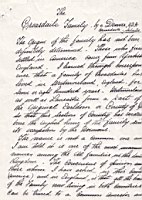
|
Page 2
house (?) are more or less related to each
other. My investigation of the American ?
families of this name tend to confirm this
opinion. There is a tradition in certain
branches of the family that it is of French
origin. While this is doubted by other members
of the source branch. I have reason to believe
from information received elsewhere (although not
actually confirmed) that this tradition is founded
upon fact and that the family is of Norman-French
origin and can be traced to the time of the Norman
conquest of England.
The use of strictly hereditary surnames as a
distinguishing mark of a family was unknown in England
before the Norman Conquest and seems to have been
still a novelty in Normandy but a novelty which was
fast taking root. In the latter country it had
begun to be looked on as a needful badge of noble
birth. Along with the foreign fashion of
hereditary surnames, a new set of Christian names came
into England with the Norman Conquest in where were
personal names more purely |
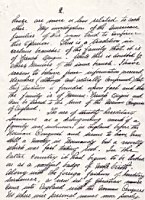
|
Page 3
Teutonic than they were in England up to the time of
the Conquest that is to say. England was
especially slow in adopting either scriptural names or
Greek or Latin names of the saints. All this
stands in marked contrast to Scandinavia where we find
scriptural names from the first moment of conversion
and to Scotland where names of every class seem to
have found common shelter. The authority for this
paragraph is “Freeman’s History of the Norman
Conquest”.
The name of Croasdaile is now spelled in three forms,
and the family may be said to be divided into three
great branches.
The first of these is the English Branch or those
descendants which have remained in England.
Among these the name is spelled Croasdale, Croisdale
or Croasdell the first being the more common.
The Second great branch of the family left England on
account of political troubles in the early part of the
17th Century during the |
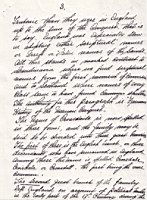
|
Page 4
reign of Charles the first and took up large tracts of
land in Ireland, this branch of the family used the
exclusive form of “Croasdaile” in spelling the name.
The Third great branch of the family is the American
Branch – which left England in the latter part of the
17th Century on account of religious
persecutions. They have used both forms – vis
“Croasdale” and “Croasdill” but at the present time
the former seems to be the most universally
used. Many of the earlier generations of this
branch have used the termination “dill” and insisted
that it was the proper form of spelling the name and
that “dale” was a new-fashioned adoption. I am
convinced, however, that the variations in spelling
the name are largely due to ? in writing and keeping
the early records rather ? the possibility of the
different ancestors. This is shown by ? of
the early American families – Thomas and Agnes
Croasdaile who came to America with William Penn, are
recorded in the “Settle Meeting of Yorkshire, England”
as “Croasdaile”. |
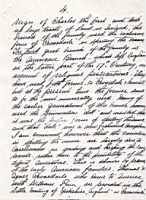
|
Page 5
The same spelling is used in the American records of
their six children – four appear on the American
records as Croasdale, one as Croasdill and one as
Crosdill (?). The father of the other American
family brought a Certificate from Brighthouse meeting
Bradford, Moorside, Yorkshire with his name spelled
Croasdill and the certificate signed by mime other
“Croasdills”. This in the year of 1685 and Exia
was a single ?. The record of births of Bradford
Moorside ? but one (Exia?) who was born in 1655 and
was the son of Wm and Grace at his birth the name is
recorded as Croysdal. His sister recorded two
years later as Croysdale. I have > record of
the spelling of the last name of the other children
but the death of his sister in 1679 is recorded under
the name of “Croasdall”. William who was
probably his father was buried at Bradford in 1691
under the name of Croasdall. These records also
show the change of name that occurred in |

|
Page 6
one family in twenty five years, as well as the common
use of all forms of spelling. In addition to the
above the name appears on the same English records as
“Croasdell” in 1662. “Croasdale” in 1693 and
“Croasdill” in 1700. The marriage of Thomas and
Agnes mentioned previously is recorded in 1664 under
the name of “Croasdall”. I have not been in a
position as yet to go back to the records of the
“Society of Friends” which began about 1650. As
seen above the form of “Croys” (for the first half of
the name was still in use previous to 1660 with the
various corruptions in the terminations) probably came
from the French “Croise” meaning Cross.
According to one authority who has followed his own
family back through the same countries and has made a
study of the Norman-French origin and was originally
Creuxthaile meaning in a free translation
“Defender of the Cross”
From this it changed with the language to
“Croisthaile”. This was probably the name in the
12th Century or at the time of the Conquest and this
particular ? |
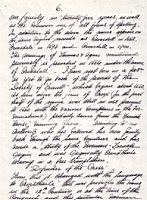
|
Page 7
evidently received the grant of land in
Yorkshire. From this the name changed to
“Croisdale” and there to “Croysdaile” which brings it
up to the ? form recorded by the Society of
Friends. This evolution of the name can no doubt
be readily traced through the proper English and
French records and properly confirmed when the
opportunity permits, but the statements are so
plausible and there is so little difference between
forms of spelling as used by the Irish branch of the
family and the form of the Normans(?) together with
the Christian significance of the name which is
indicative of Norman blood or influence that it seems
as if there could be little doubt as to the
correctness of this statement as to the origin of the
family. Two coats-of-arms belong to the
Croasdaile family. One of these clearly belong
to the English branch and I suppose the American
branch from England can trace a title to it. My
authority on the origin of the name says the latter
coat-of-arms is distinctly Norman. |

|
Page 8
The former was not submitted to him but must be Norman
also. In regard to this I again quote from
“Freeman’s history of the Norman Conquest” as
follows. Here again we must look on the
introduction of knighthood in the special s? of
heredity ? and the whole range of these ideas
connected with ? as the result of the Norman Conquest,
but its ideas and outward badges ? in France but also
in Germany. It seems to me that the Coat of Arms
also tends to confirm the Norman origin of the
family. The arms of the Irish branch of the
family is as follows:
A silver shield with one chevron of blue. On the
shield are three ? cocks – two above and one below the
chevron. The motto “alert” the ? is a cock like
those on the shield with alert on a strap above. |
`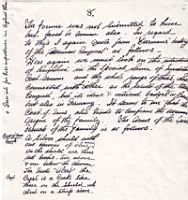
|
Page 9
The arms of the English branch is a shield of Azure
blue with these chevrons of gold. At the centre
of each chevron is a mullet on st? ? figure in
red. There is no motto. The crest is a
knight in armour with open visor. Note:
Mullets are used in heraldry to denote the 3rd
son.
While those members of the American branch were called
Yeomen there is but little doubt that the original
branch or family occupied a prominent position in
Yorkshire at one time.
There is an old grouse moor in that country that is
still called Croasdale Moor situated in the north part
of Lancashire. |
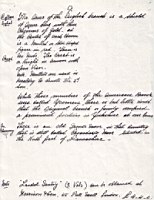
|